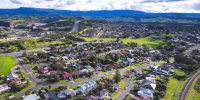
Photo by Alberico Bartoccini on Unsplash
Why the Reserve Bank of Australia should lift the interest rate 0.5 per cent this week
An inflation-targeting framework being pursued in Australia relies on information on inflation that is already out of date by the time it is used to make crucial decisions, Warwick McKibbin writes.
With the inflation rate in Australia now at 5.1 per cent (or 3.7 per cent in terms of the trimmed mean inflation), the Reserve Bank of Australia (RBA) faces the same dilemma as almost all central banks around the world. Should the policy interest rate be increased? How much should interest rates go up between now and when inflation is expected to stabilise within the band of two to three per cent?
This band is set out in the Statement on the Conduct of Monetary Policy as the key aspect of implementing the mandate of the RBA. With inflation outside the band, action is needed unless it is clear that the event is only temporary. An even more critical question is whether the goal of the Reserve Bank to target inflation within the band of two to three per cent over the cycle is even the appropriate monetary framework in 2022.
For some time, economists have argued that inflation targeting is past its use-by date. The economy is experiencing dramatic supply shocks such as the COVID-19 pandemic, the Russia-Ukraine war, the increasing volatility of the climate, and the necessity for significant climate policy that will transform the supply side of the global economy.
Inflation targeting is not the best monetary framework under these circumstances. Despite this debate, the RBA Board needs to decide on the policy interest rate on Tuesday.
There are several points to stress about the recent inflation rate. The inflation figure is not the current inflation rate in May or even last month – it is the change in prices over the 12 months to the March quarter this year.
What matters is what the inflation rate is expected to be over the next year or two. This is one of the critical problems of the inflation-targeting framework. The inflation rate itself is an index that is the price of a bundle of goods for a representative Australian household. It takes time to collect and process the data.
It may surprise many readers that in 2022 the monetary framework has a target that relies on outdated information when enormous amounts of real-time data are available.
The Australian Treasury used real-time data from several sources, including credit card receipts, to design policy interventions during the COVID-19 pandemic. This information could be used in a timely fashion to know precisely what the state of the economy is today.
Delayed information and forecasts are the basis of RBA decision-making, but the inflation rate as the core of the policy framework is already out of date when produced. The RBA is driving the economy forward while looking through the rearview mirror. An alternative RBA target such as the growth rate of total current (nominal) spending in the economy would be instantly and continually available to policymakers and the markets.
Another important consideration is, what is currently driving inflation? Prices rise when demand exceeds supply. Excessive demand is being caused by ultra-loose monetary policy worldwide and large fiscal deficits in many countries, including Australia, while there are global and Australian supply disruptions due to the COVID-19 pandemic and the war in Ukraine.
Raising interest rates in the face of rising demand works because this chokes off demand. Increasing the policy interest rate in the face of contracting supply also reduces inflation but reduces output and increases unemployment. This outcome contradicts the RBA mandate. The critical question for central bankers is how much of inflation is demand-driven and how much is supply-driven? It is probably equal parts of both in Australia, which means either a large increase or no change in the policy rate is the wrong response.
I have first-hand experience of this dilemma as a member of the RBA board that raised interest rates from 6.5 per cent to 6.75 percent on 7 November 2007, just before the federal election.
My approach then as it is now is to consider, given the state of the economy and the expected path over the next year, what would a neutral policy interest rate be? What is the policy interest rate that neither slams on the brakes nor steps on the accelerator?
This is highly uncertain in reality but can be approximated by adding the underlying equilibrium real interest rate to a medium-term inflation rate.
A plausible estimate of the equilibrium real interest rate (real r* in the academic literature) is around one per cent (down from more than three per cent in the 1990s). Assuming inflation is in the middle of the RBA target at 2.5 per cent, a neutral rate might be around 3.5 per cent.
The current target policy rate is 0.1 per cent. With historically low unemployment and sizeable fiscal spending promised by both political parties, the foot is on the accelerator for both monetary policy and fiscal policy. The longer the accelerator is pressed, the harder it will be to slow inflation and the greater the economic costs of rebalancing the economy.
The RBA must acknowledge the problem of excessively loose fiscal and monetary policy (the world today is not different to the standard macroeconomic textbook – but there are multiple complex shocks and lags).
The RBA should outline the logic of the policy response and a time frame for raising rates that can be transparently adjusted as new information arrives. Given this approach, they should raise rates to 0.5 per cent on 3 May and announce a path of interest rate increases to at least two per cent over the coming months but subject to allowing for new information on the adjustments that this policy causes. A critical piece of data is the outcome for wage growth – the next release is 18 May.
Inflation is driven by growth in prices of goods and services in the index, reflecting the increase in input costs in producing goods and services. Wages are the largest share of input costs and, therefore important. If wages rise without any associated productivity increase, then prices will increase. Once rising inflationary expectations cause a rise in wage claims, an inflation spiral like the 1970s can take off along with the economic costs of reducing inflation.
The RBA will likely only move to 0.25 per cent on 3 May, but the messaging of the path for policy interest rates, explaining the reasons for the move, will be more important than the size of the action.
This week is a critical moment when the monetary policy decision can have long term implications for the economy. Untangling the impacts of the extreme global and domestic shocks and designing the monetary response is extremely difficult but the analysis and ultimate decision should be independent of the politics of the electoral cycle.
This piece was first published by the Australian Financial Review.
Updated: 18 August 2024/Responsible Officer: Crawford Engagement/Page Contact: CAP Web Team













